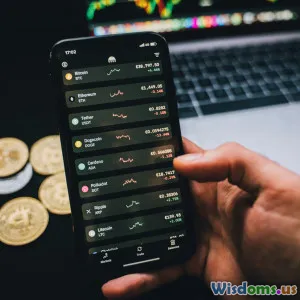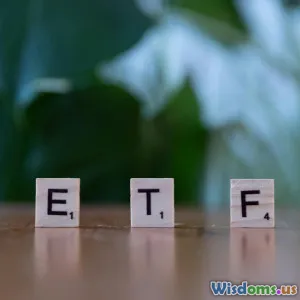
Building a Digital Investment Portfolio
8 min read Master the art of building a digital investment portfolio to diversify assets and maximize returns in today’s evolving financial landscape. (0 Reviews)
Building a Digital Investment Portfolio: A Modern Guide to Diversifying Wealth
In today’s rapidly evolving financial world, the concept of an investment portfolio has transcended traditional stocks and bonds. The digital realm, powered by blockchain and fintech innovation, offers new avenues for investors ready to diversify intelligently. But how does one start building a digital investment portfolio effectively? This article explores the core strategies, challenges, and opportunities you must know to create a balanced, forward-looking portfolio that capitalizes on the digital revolution.
Why Build a Digital Investment Portfolio?
The rise of digital assets—cryptocurrencies, tokenized real estate, and decentralized finance (DeFi)—has fundamentally shifted how wealth can be diversified. According to a 2023 report by Deloitte, digital assets attracted over $45 billion across various platforms globally, reflecting surging institutional and retail investor interest.
Moreover, digital investments can offer:
- High liquidity: Many digital assets trade 24/7 globally, unlike traditional markets.
- Accessibility: Anyone with an internet connection can participate, democratizing investing.
- Innovation exposure: Invest early in disruptive technologies like NFTs, blockchain projects, and more.
As Pomp Investments CEO Anthony Pompliano said, "Digital assets represent the next wave of growth, much like the internet stock boom of the ’90s.” Recognizing this, savvy investors are building portfolios that blend traditional assets with digital ones.
Core Components of a Digital Investment Portfolio
1. Cryptocurrencies
Digital currencies such as Bitcoin and Ethereum often form the backbone of a digital portfolio. Bitcoin’s scarcity and Ethereum’s smart contract functionality have made them blue-chip digital assets.
- Example: A typical portfolio might allocate 40-60% to cryptocurrencies, with a heavy emphasis on Bitcoin for stability and Ethereum for growth potential.
2. Decentralized Finance (DeFi) Tokens
DeFi projects create blockchain-based financial services without intermediaries. Investing in governance tokens of platforms like Aave, Uniswap, or Compound offers exposure to this space.
- Real-world insight: Participating in DeFi staking or liquidity pools not only earns token rewards but fundamentally backs decentralized financial infrastructure.
3. Non-Fungible Tokens (NFTs)
While volatile, NFTs representing digital art, collectibles, or virtual real estate have gained interest for unique value propositions and cultural relevance.
- Example: Early investors in NFTs like CryptoPunks have seen astronomical returns as proof of digital ownership and scarcity concepts took off.
4. Security Tokens and Tokenized Assets
Real assets like real estate, equities, or commodities can be tokenized on blockchains, combining liquidity, transparency, and fractional ownership.
- Fact: Platforms like RealT enable investors worldwide to own fractions of rental properties via blockchain tokens, earning rental income seamlessly.
5. Digital Funds and ETFs
To reduce complexity, some choose digital asset-focused funds or ETFs, managed by experts with exposure to baskets of digital assets.
- Data point: The Grayscale Bitcoin Trust had assets over $10 billion in early 2024, demonstrating institutional appetite for managed exposure.
Strategic Steps to Build Your Digital Portfolio
Step 1: Define Your Investment Goals and Risk Tolerance
Understand whether your horizon is long-term growth, income generation, or speculative trading. Digital assets are often volatile, so an honest assessment of your risk comfort is essential.
Step 2: Educate Yourself Continuously
The digital investment landscape changes fast. Follow trusted sources like CoinDesk, invest in courses on blockchain technology, and monitor regulatory updates.
Step 3: Choose the Right Platform
Select exchanges and wallets with proven security track records. For example, Coinbase and Binance offer user-friendly interfaces, whereas hardware wallets like Ledger provide enhanced safety.
Step 4: Diversify Across Asset Types
Avoid the pitfall of overconcentration in one asset. Combine cryptocurrencies with DeFi projects, NFTs, and tokenized traditional assets.
Step 5: Implement Strong Security Practices
Use two-factor authentication, cold storage wallets, and regularly update software. Hundreds of millions of dollars have been lost through hacks due to complacency.
Step 6: Regularly Review and Rebalance
Monitor market movements and portfolio performance quarterly to adjust allocations toward your evolving goals.
Real-World Success Stories
- Michael Saylor: Former MicroStrategy CEO famously converted large corporate cash reserves into Bitcoin, showcasing corporate adoption of digital assets.
- NFT pioneers: Early collectors who bought digital art pieces like Beeple’s iconic 'Everydays' realized multimillion-dollar gains, propelling the NFT ecosystem.
These examples underscore that thoughtful, bold digital investing can lead to substantial upside.
Challenges and Risks
No investment is without risks. Digital portfolios face:
- Regulatory uncertainty: Jurisdictions vary widely in treatment—recent crackdowns in China and policy shifts in the US affect asset values.
- Volatility: Sharp price swings can be significant—Bitcoin has seen 80% corrections previously.
- Technology risks: Hacks or flawed smart contracts expose investors to loss.
Balanced risk management and diversified strategies help mitigate these issues.
Looking Ahead: The Future of Digital Investing
Emerging trends such as the integration of artificial intelligence in asset management, increasing institutional entry, and cross-border digital asset trading point to a vibrant future. Blockchain innovation is also paving the way for programmable money and novel investment products.
Conclusion
Building a digital investment portfolio is no longer just an option for tech-savvy millennials —it’s becoming a mainstream component of wealth management. With a clear understanding of asset categories, security priorities, and strategic diversification, investors can harness the potential of digitized assets while managing risks.
As with all investments, the key to success lies in informed decision-making and patience. Begin your journey today by learning, choosing wisely, and staying adaptive to changes in this exciting financial frontier.
Take charge of your financial future by embracing the digital investment revolution.
References:
- Deloitte Global Blockchain Survey 2023
- Grayscale Investment Reports 2024
- CoinDesk Market Analytics
- Interviews with Anthony Pompliano
Rate the Post
User Reviews
Popular Posts




















